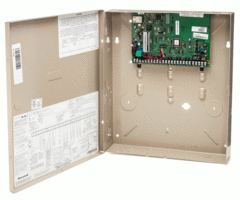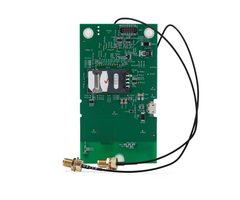VISTA 21iPLTE vs. VISTA 21iP
The VISTA 21iPLTE and the VISTA 21iP are almost the same hardwired alarm control panel from Resideo. But there is one major difference between the two. The VISTA 21iPLTE is capable of supporting a plug-in LTE communicator, in the form of the LTE-21V, while the VISTA 21iP cannot support it.

In almost every possible aspect, the VISTA 21iPLTE and the VISTA 21iP are the same panel. They have the same number of zones (up to 64 total), the same general specifications, and the same add-on needs. Both have the same built-in IP communicator that allows for a hardwired ethernet connection. These panels only differ in the cellular communicators that they support. If you never plan to use cellular communication with the system, then a regular VISTA 21iP will be no different to you than a VISTA 21iPLTE.
The difference between the VISTA 21iPLTE and the VISTA 21iP lies in the cellular communicators they support. The VISTA 21iPLTE can support the plug-in LTE communicator, the LTE-21V. This communicator is designed exclusively for use with the VISTA 21iPLTE System. No other system can support it. By adding this communicator to a VISTA 21iPLTE, you can continue to use the system's built-in IP communicator. This will make the system dual-path ready.
The VISTA 21iP Panel had a plug-in communicator at one point. It was known as the VISTA-GSM4G. However, with the 3G/4G sunset, it is no longer possible to activate a VISTA-GSM4G. You now need to get an LTE communicator if you want to use cellular with a VISTA Panel. Currently, the only plug-in cellular communicator that can be activated for a VISTA Panel is the LTE plug-in communicator for the VISTA 21iPLTE. If you are trying to decide between a VISTA 21iPLTE and a VISTA 21iP, and you plan to use cellular communication with the system, make sure to get a 21iPLTE so you can use this plug-in module.
If you have a standard VISTA 21iP Panel, then it is still possible to use LTE cellular communication with the panel. It is just more difficult than using one of the plug-in LTE cellular modules that the VISTA 21iPLTE supports. In any case, adding an LTE communicator to a standard VISTA 21iP requires disabling the built-in IP communicator for the system.
If you just want cellular communication for a 21iP, and you do not care about IP connectivity, then you can get a Honeywell LTEM-XA (AT&T LTE) or a Honeywell LTEM-XV (Verizon LTE). If you want dual-path connectivity with both IP and cellular, you can choose between a Honeywell Home LTEM-PA (AT&T LTE Cat M1 & IP) and a Honeywell Home LTEM-PV (Verizon LTE Cat M1 & IP). If you use an LTE-IA or LTE-IV, you will technically still need to disable the built-in IP communicator for the VISTA 21iP System. But it will be okay, as the new communicator will provide IP connectivity.
Technically, you can use any of the aforementioned communicators with a VISTA 21iPLTE as well. This includes the LTEM-XA, LTEM-XV, LTEM-PA, and LTEM-PV. But there is no reason to do so, as you can just get a plug-in LTE-21V (Verizon LTE) module. This communicator is made exclusively for the VISTA 21iPLTE, and it does not require you to disable the built-in IP communicator for the system. The LTE-21V is much easier to install and is more cost-effective than adding a separate communicator.
One exception would be if the panel is located in an area without adequate Verizon LTE Cat M1 signal strength. In that case, if a VISTA-21IPLTE has already been installed, then adding an external AT&T LTE-capable cellular communicator makes sense. If you're planning a system that requires AT&T as the cellular provider, then you would be better off installing a VISTA-20P with one of the aforementioned external AT&T communicators.
|
|
VISTA 21iPLTE |
VISTA 21iP |
| IP Communication | Yes (built-in) | Yes (built-in) |
| Cellular Communication | Yes (add-on needed) | Yes (add-on needed) |
| Supports LTE Plug-In Modules | Yes - LTE-21V | No |
| Total Zones | 64 | 64 |
| On-Board Hardwired Zones | 8 | 8 |
| Max Hardwired Zones | 48 (Five 4219 Expanders) | 48 (Five 4219 Expanders) |
| Max Wireless Zones | 56 (wireless receiver needed) | 56 (wireless receiver needed) |
| Key Fob Zones | 16 | 16 |
| Max Keypads | 8 | 8 |
| Max AUI Devices | 4 | 4 |
| Partitions | 2 (Partition 3 is common) | 2 (Partition 3 is common) |
Did you find this answer useful?
We offer alarm monitoring as low as $10 / month
Click Here to Learn MoreRelated Products



- Answered

